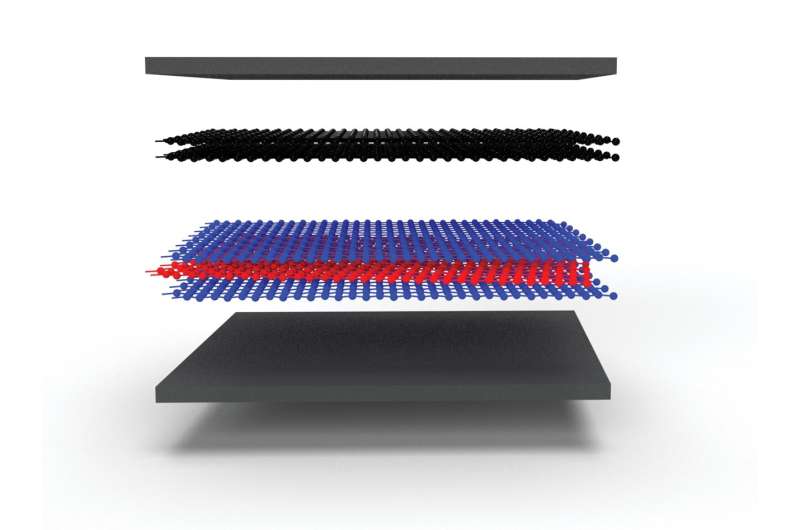March 29, 2022 feature
Study improves the understanding of superconductivity in magic-angle twisted trilayer graphene

In recent years, physicists and material scientists have uncovered several new platforms for studying correlated phases of matter, such as superconductivity and the correlated insulator phase. Among them is magic-angle twisted trilayer graphene, a superconductor discovered by a research team at Massachusetts institute of Technology. This material consists of three sheets of graphene stacked together, with a rotational misalignment of approximately 1.5 degrees.
Past studies found that magic-angle twisted trilayer graphene exhibits superconductivity at remarkably high magnetic fields, far higher than those it would be able to endure if it were a conventional superconductor. While the superconductivity of this material is now widely documented, its underpinning physics is not yet fully understood.
Researchers at Brown University have recently carried out a study further investigating superconductivity in twisted trilayer graphene. Their paper, published in Nature Physics, introduces important constraints that could shape existing theoretical models of superconductivity.
"A few previous experiments showed that the superconducting phase in magic-angle twisted trilayer graphene survives to a large external magnetic field that violates the so-called Pauli limit, where electron pairs with opposite spin orientations are expected to be destroyed," Jia Leo Li, one of the researchers who carried out the study, told Phys.org. "The fact that superconductivity violates this limit provides strong indication that electron spins in a Cooper pair are aligned in the same direction."
The key objective of the recent work by Li and his colleagues at Brown University was to better understand the unusual superconducting behavior observed in magic-angle twisted trilayer graphene. To do this, the team used a technique called Coloumb screening, which allows scientists to investigate the role of Coulomb interactions in stabilizing the superconducting phase. Ultimately, this led to new findings that enrich the current understanding of the mechanism underlying superconductivity in the promising new material.
"Last year, we demonstrated that one can directly manipulate the strength of the Coulomb interaction using a specially designed 2D material hetersotructure," said Jia Li, an assistant professor of physics at Brown and corresponding author of the research. "The response of superconductivity to varying Coulomb interaction tells us something important about that system. In this case, we showed that weaker Coulomb interaction strengthens superconductivity."
The screening technique used by Li and his colleagues was unveiled by them in one of their previous studies, led by Xiaoxue Liu. Liu is a post-doctoral researcher at Brown University and a pioneer in the study of graphene moiré systems using 2D material structures with complex design.
"The screening measurement we collected in twisted trilayer graphene shows similar results compared to the same measurement performed on magic-angle graphene bilayer, which suggests that superconducting phases in these two systems have a common origin," Li said. "Our most notable result is that the (pairing) glue for the superconducting phase in twisted trilayer graphene appears to be competing against Coulomb interaction. "
The findings offer valuable new insight that significantly advances the present understanding of superconductivity in twisted graphene structures. In the future, the team plans to investigate this promising structure further, while also using the same technique employed in their recent study to examine other materials.
"The behavior we observed provides strong support for a group of theoretical models, whereas it rules out another group of possibilities," Li added. "Coulomb screening is a powerful technique. We now plan on applying this same technique to learn more about superconducting phases in 2D materials."
More information: Xiaoxue Liu et al, Isospin order in superconducting magic-angle twisted trilayer graphene, Nature Physics (2022). DOI: 10.1038/s41567-022-01515-0
Journal information: Nature Physics
© 2022 Science X Network




















